東京大学 羽藤研究グループ > 講座 > 2018 > 行動モデル夏の学校2018 > 当日のまとめ
第17回行動モデル夏の学校2018は,東京都・文京区の東京大学本郷キャンパスにて,2018年9月14日から16日にかけての3日間,講師15名,参加者90名(うち聴講者12名)によって行われました. 基調講演 Keynote lecture / 講義 Lectures / |
基調講演 Keynote Speech
Prof. Takayuki Morikawa (Nagoya University)
Incorporating psychological factors into discrete choice models
|
The keynote lecture started with Max Weber's four types of action. Generally, economics usually treats rational & repetitive actions. In this case, consumer's behavior is defined by the utility function and some restraints. Discrete choice models, such as MNL, have been developed under such assumptions. There are two types of data often used for model estimation, one is the RP (Revealed Preference) data, and another is SP (Stated Preference) data, which includes the preference information declared by interviewees, in hypothetical situations. In model estimation, the attributes of both alternatives and decision-makers should contain subjective perception and attitude. Therefore, it is necessary to combine economic data with psychometric data. Morikawa, Ben-Akiva, and McFadden have developed an integrated framework for demand analysis, utilizing both econometric data and psychometric data. In this framework, he adopted latent explanatory variables, which express subjective attitude and perceptions, and the RP/SP combined modeling is found to be useful for the measurement of the quantitative value of the intangible factors. He also introduced the Two-Stage Probabilistic Choice Set Model. In this model, The choice set is not given but formulated. As the computing power is advancing these days, any types of discrete choice models can be estimated, and machine learning is even more powerful to forecast human behavior, but it is necessary to keep in mind that we cannot understand the behavior only by the machine learning methods. (PDF Document) |
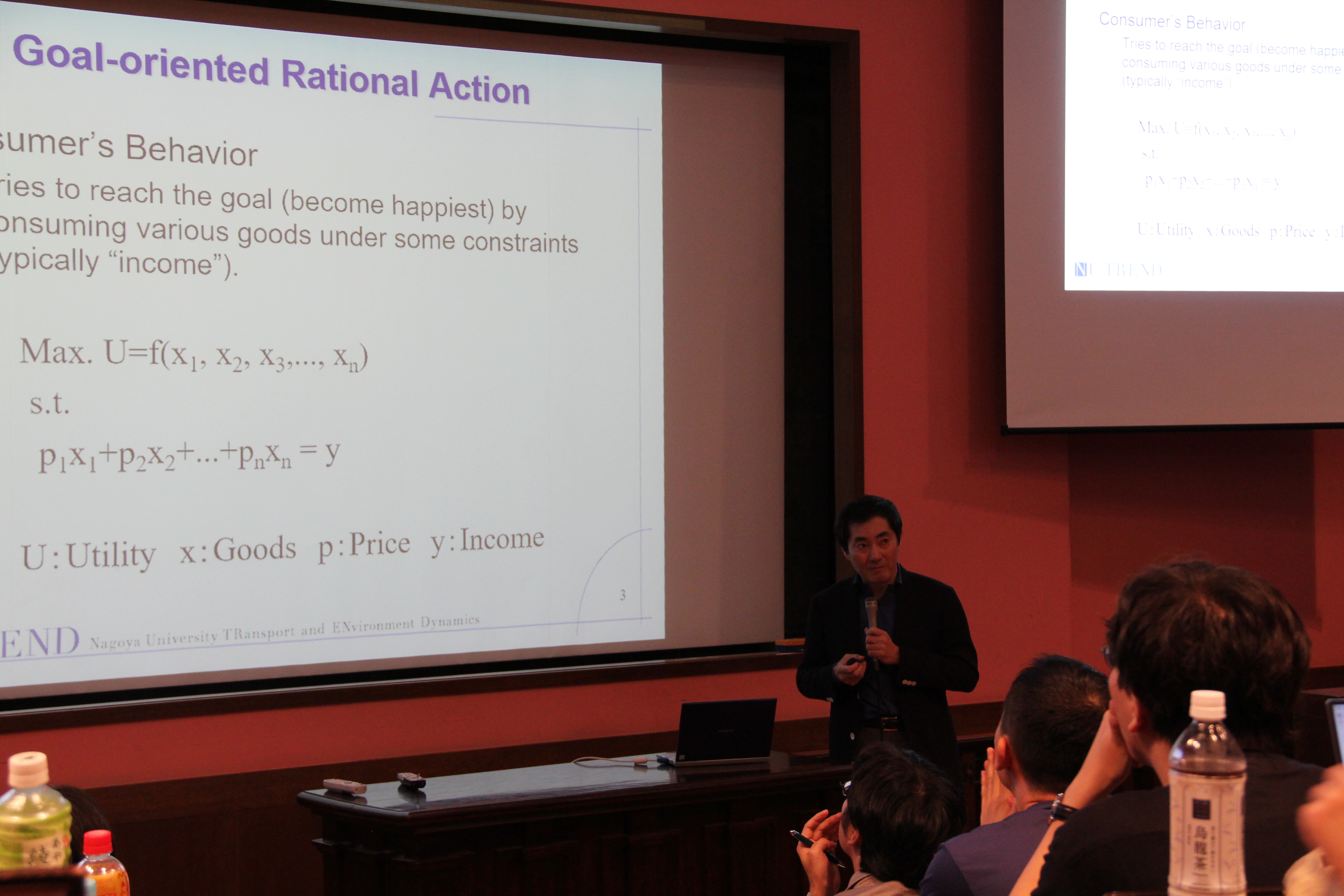
|
講義 Lectures
Behavioral modelling theory and estimation methods
|
Arnab Jana(IIT Mumbai) Travel demand model is necessary for the forecast of transportation demand. In general, the four-step model is useful for the prediction of the travel demand. The four-step model consists of trip generation, trip distribution, modal split, and assignment. In the step of trip generation, we predict the number of trips generated in (Oi) and attached to (Di). In the next step, we estimate the zone to zone movements. i.e. OD table. In the step of mode choice, when the preference of the individual is unknown, we adopt the discrete choice model to calculate the probability. In the last step, we allocate the trips between each link, under the assumption of user equilibrium. There are still some limitations to the four-step model because that model does not regard a travel as demand derived from the activity participation results. Therefore, there is a necessity of the Activity-Based Based Travel Demand Modeling. In the ABM model, trips are not independent but associated with each other. The ABM model is theoretically based on the human behavior and gives us better understanding and prediction of traveler's behavior. (PDF Document) |
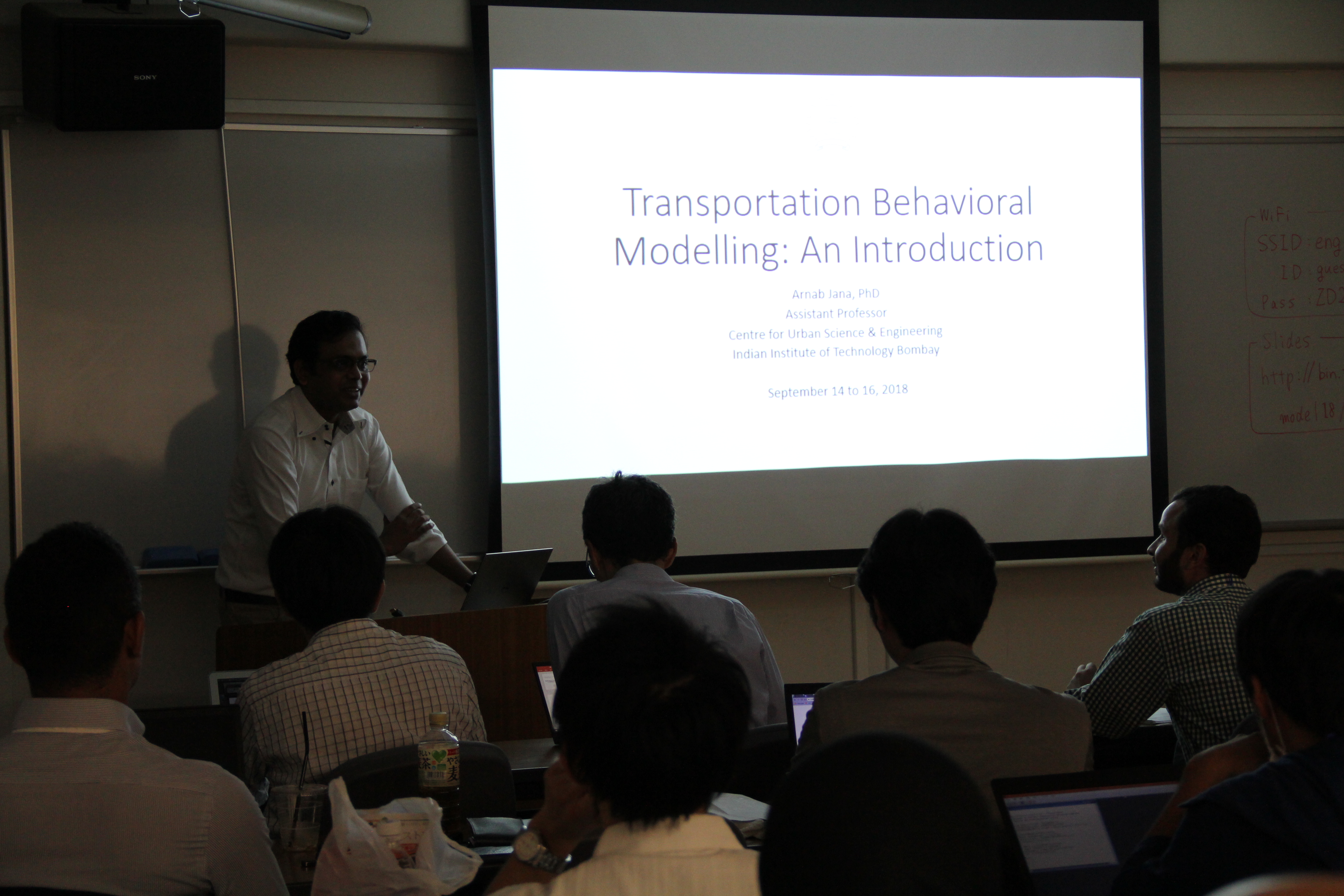
|
|
Giancarlos Troncoso Parady(Univ. Tokyo) To some extent, modeling is an "art" as much as is a science. When we specify the utility function by observable variables and the error term, error term reflects the sources of randomness. When the error term follows the normal distribution, the choice model is called a probit model, which is quite flexible but requires much computation power. The logit-model is a probit-like model that approximates a normal distribution and in this model, when the error terms follow the i.i.d. Gumbel distribution, we can express the probabilities in a closed-form, so it is analytically convenient. The logit-model is tractable, but the validity of the choice axiom fails when the alternatives are not distinct because of the IIA constraint. Therefore, the logit model can capture the dynamics of the repeated choices if unobserved factors are independent over time only. Using the result of parameter estimation, we can measure the elasticities and the marginal effects. The parameters of each variable are optimized through maximizing the log-likelihood function, and we can calculate the goodness of fit by the likelihood ratio test, but we must keep in mind that good fitting models can still result in erroneous predictions. (PDF Document) |

|
|
Toshiyuki Yamamoto (Nagoya Univ.) We need to improve the model in terms of calculation speed, then we should compare between Binary Logit model & binary probit model, MNL model & NL model, and NL model & MXL model. Then, we have to apply the following assumption for scale parameters to these models. In the first comparison, μ and σ cannot be identified because of β. Therefore standardization of μ and σ is necessary: μ = σ= 1. In the next comparison, standardization of μ as 1 is recommended to keep the size of β in order to compare with the multinomial logit model because of two error terms for NL model. In the third comparison, considering [only difference in utility matters], setting εI’ = εI - εT and εT’ = 0 gives the same β because different probability distributions are mixed in the mixed logit model. (PDF Document) |
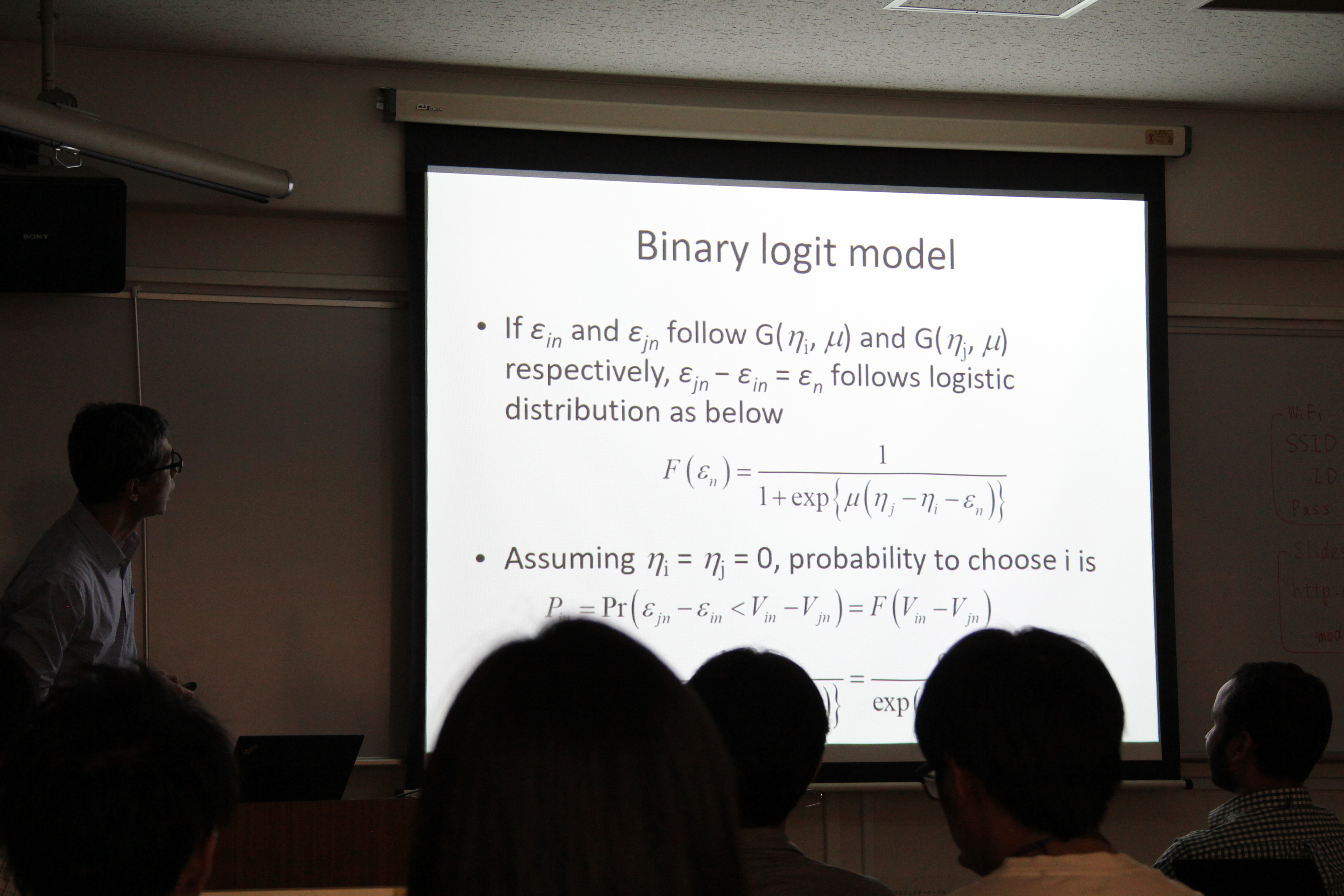
|
行動モデルの基礎と推定
|
倉内慎也(愛媛大) 行動モデルは主体の意思決定を,新古典派ミクロ経済学における効用に着目し,観測可能な確定項と観測不可能な要素を確率的に扱う誤差項の和とした効用を最大化する選択行動をとる(ランダム効用理論)という仮定をおいてモデル化している.モデルを構成する説明変数やパラメーター,選択肢集合,誤差項にもいくつかの仮定をおいており,行動モデルの分野は,これらの仮定を緩めることで現実とより整合性のあるモデルを開発する方向に発展していった. (PDF Document) |
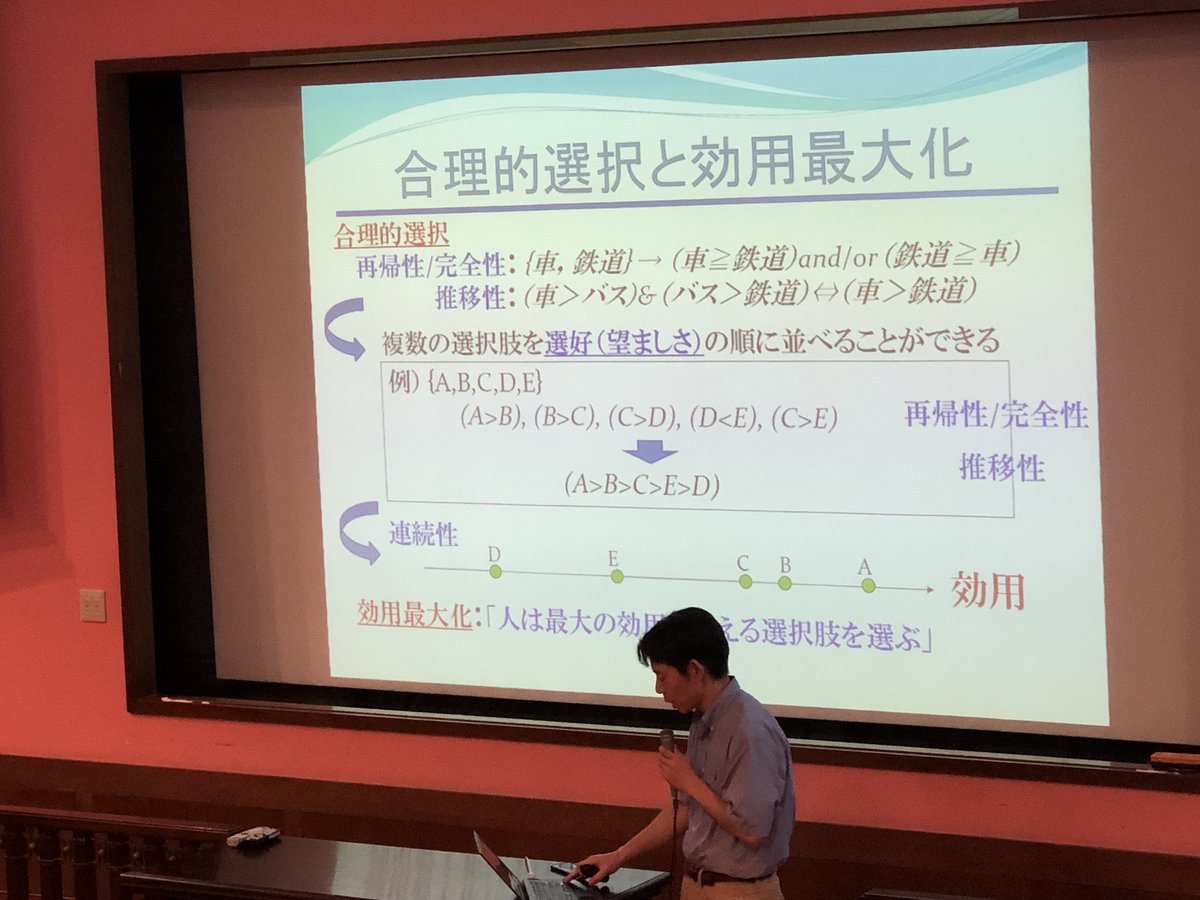
|
|
佐々木邦明(山梨大) 行動モデルのモデル式中のパラメータ推定手法としては、最尤推定法が代表的である。ここでは、尤度関数が最大となる点を近似計算により求めるが、その際の計算アルゴリズムで代表的なものとして、準Newton法など3種類を示している。さらに、推定が成功しないケースについて、典型的な原因をいくつか紹介している。最尤推定法がうまくいかない場合に、シミュレーションを用いる手法がある。これは、誤差項の確率密度関数に従う乱数を発生させて尤度関数を最大化するという考え方であり、MSLが紹介されている。また、特に多くのデータが継続的に取得できる際の手法として、ベイズ推定を用いるものも存在する。最後に、不完全データを扱う際の最尤推定手法として、EMアルゴリズムを示している。 (PDF Document) |
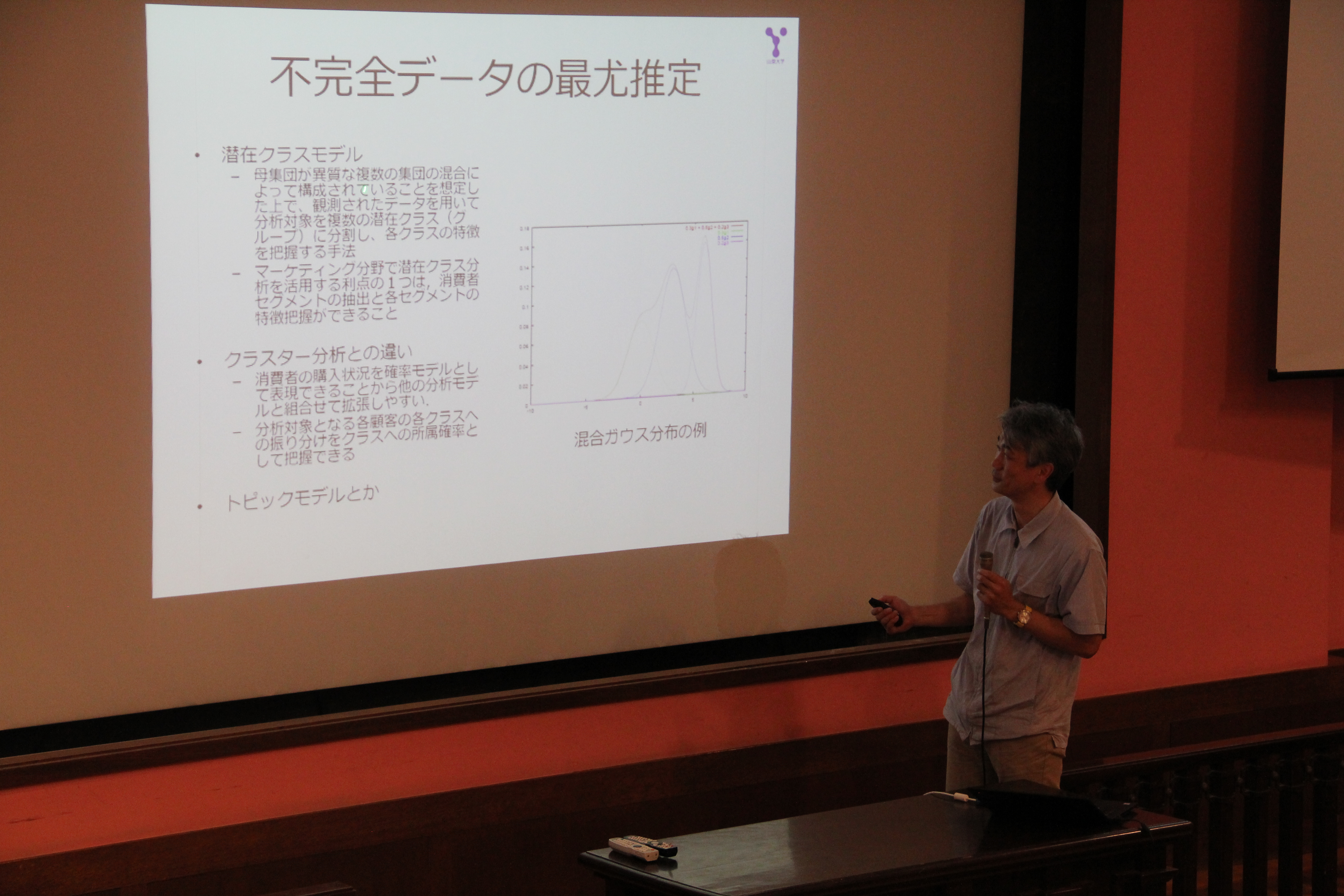
|
|
浦田淳司(東京大) 行動モデルを扱う際の最適化問題として、行動選択肢という離散量を扱う効用最大化と、パラメータという連続量を扱う尤度最大化を考えることが多い。ここでは、「交通行動の選択においては、それより後の場面のことを意識して選択を行う」ということを念頭におき、両方の定式化を行う。前者については、離散最適化の枠組みでのアクティビティモデルとしてRecker(1995)を示し、様々な制約条件のもとで、一日のトリップチェインとして最適なものを求めるための定式化を行っている。また後者については、Bellman(1953)の動的離散選択モデルを示し、定式化を行っている。さらに、推定における計算手法についてNFXP法などいくつかを示し、それらを比較している。 (PDF Document) |
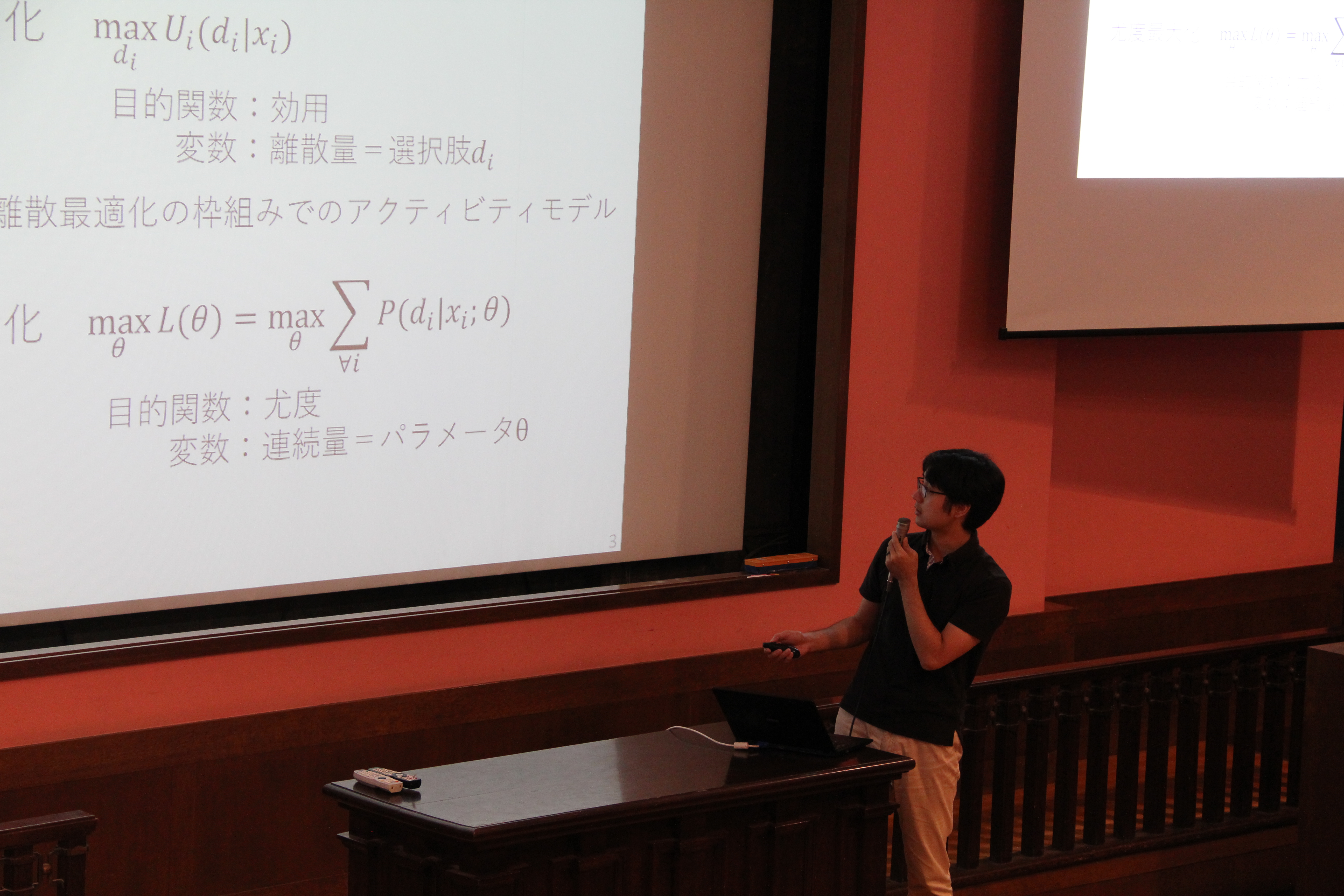
|
ネットワーク上の行動モデルとUrban Science:理論と観測
|
円山琢也(熊本大) 組み合わせ最適化は交通の分野でも広く応用されており,その一例として二段階最適化問題で記述された混雑課金の政策評価が紹介された.評価対象となる利用者の行動のモデル化が重要であるため,それらの利用者行動を集計した配分に焦点を当てるが,既存のモデルでは容易に解くことができない.そこで,配分問題を等価な数理最適化問題に置き換えた手法が近年多く提案されている.距離依存・走行時間単位コードン課金の最適化の例では,ログサム変数の導入によりロジット・エントロピー双対関係へ展開する手法を通してコードン領域の最適設定と課金関数の最適化の同時計算が行えることが示された. (PDF Document) |
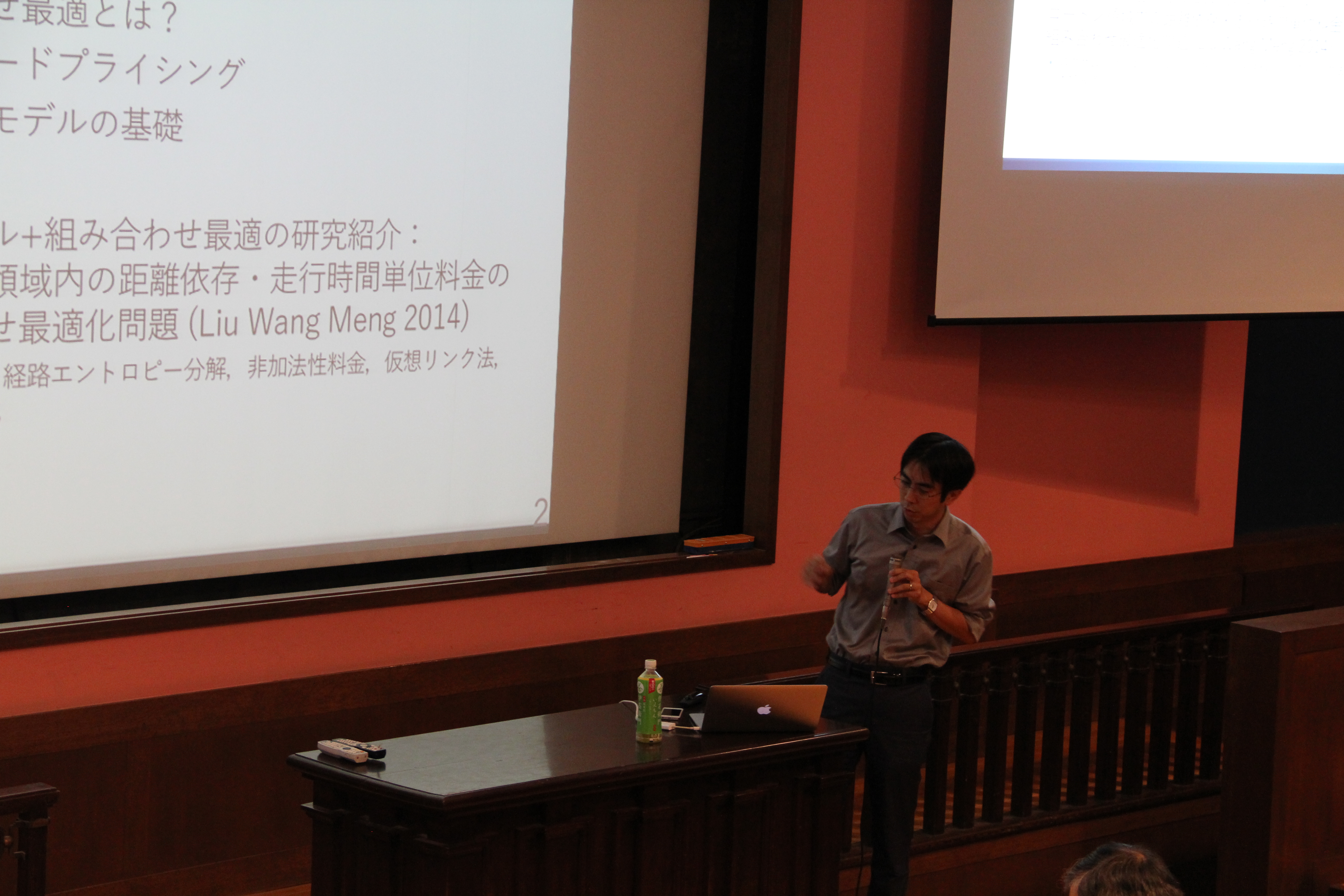
|
|
福田大輔(東工大) 数理最適化の分野で用いられてきた双対性の概念を行動モデルへ導入した研究として,ランダム効用モデルを拡張した一般化エントロピーモデルが紹介された. 双対性は,双対問題の最適解が主問題の最適解に一致する特徴を持ち,主問題が解きづらい場合に有効な概念である.それを用いて直接効用関数について効用最大化を行うことでロジットモデルがエントロピーモデルと同型の問題から導出でき,その拡張として,ランダム効用理論の下でログサムの式で定義される期待最大効用(間接効用関数)は,シャノンエントロピーで定義した直接効用関数を効用最大化したときの最適解と一致する.ここから得られる一般化エントロピーモデルは,情報量という観点から情報獲得の影響を考慮した不確実性下での離散選択モデルの基礎として合理的無反応モデルへと拡張できる. (PDF Document) |

|
特別講義
|
浅見泰司(東京大) 人口減少時代を背景に,国内の都市計画分野において既存都市制度からの転換が課題となる中で,ビッグデータを用いて即時的な計画実行及びその評価改善の試みや,スマートシティの取り組みが行われている.特にスマートシティに関しては,混雑回避システムや運転支援システムなど社会全体の最適化を目指す技術開発が行われている.行動モデルを用いた分析と政策提言については,住宅内で行われていたことが機械化されたり外部化されたりしてきたように,都市生活の変化と進展が交通行動を変えていく可能性を是非考慮してほしい. (PDF Document) |

|
Urban science and behavioral informatics with AI/machine learning
|
Makoto Chikaraishi (Hiroshima Univerisity) The condition for being a good behavior model is high predictability and high interpretability. Also, there are two general features of machine learning(ML). Firstly, ML is very high predictability for short-run forecasting. Secondly, The result of ML has little theoretical foundations. Even it is difficult to identify the factors affecting the outcome when using deep learning techniques. In this lecture, we review some recent studies which attempt to solve the shortcomings of ML methods in the context of modeling discrete choice behavior. There is a high possibility of utilizing machine learning techniques to improve behavioral models, while satisfying basic requirements such as having solid microeconomic foundations. (PDF Document) |
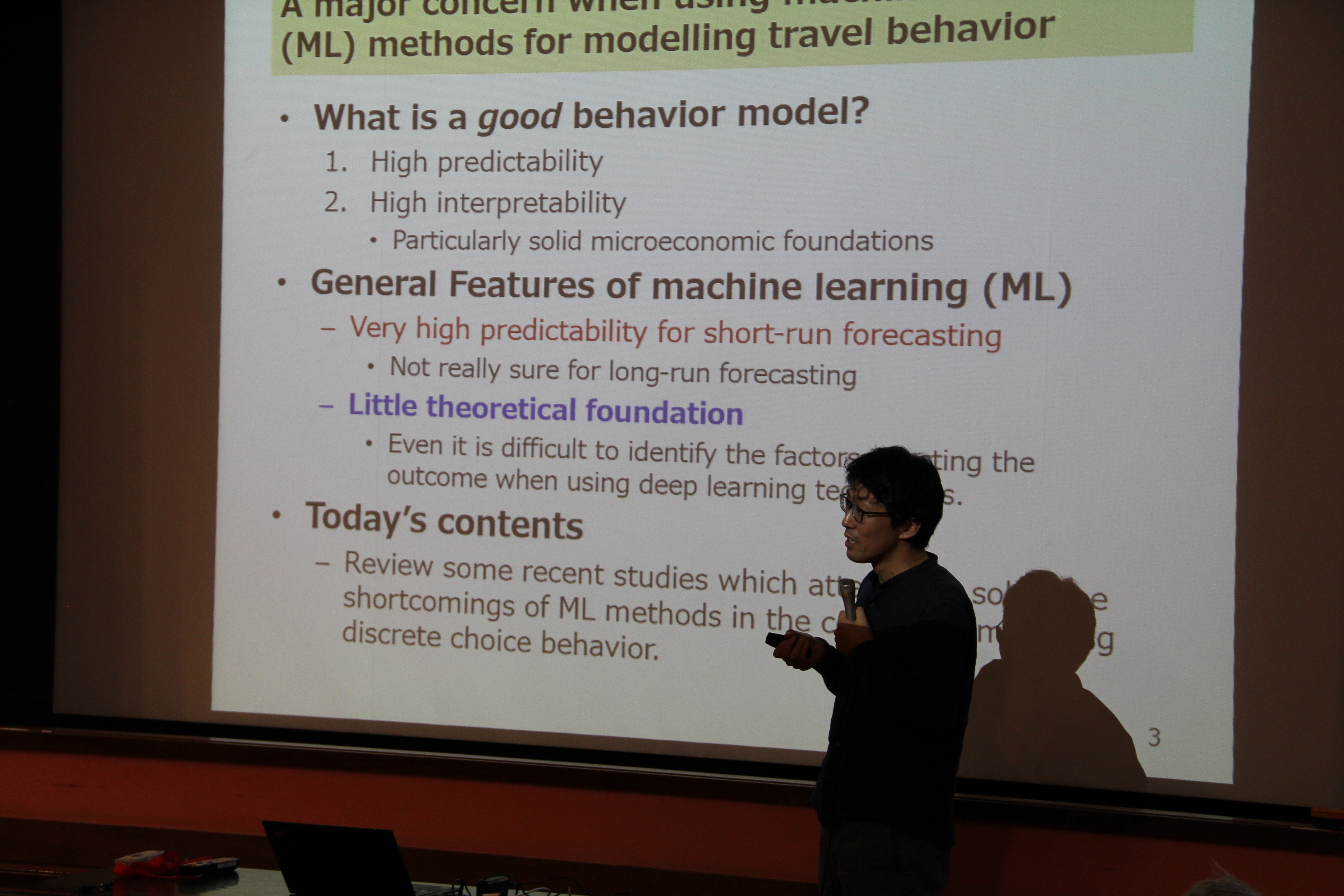
|
|
Muhamad Awais Shafique (University of Central Punjab) Machine learning(ML) is invading civil engineering and applications are endless. There are many types of learning algorithms. For example, supervised learning, unsupervised learning, semi-supervised learning, and reinforcement learning. When we use ML, we use data collection methods, feature engineering, and classification algorithms.As a development of ML, data collection methods are also developing. Feature engineering is the process of using domain knowledge of the data to create features that make machine learning algorithms work. In ML, we need two types of data, training data, and testing data. Training data is a part of data used to train algorithm, and testing data is a part of data used to test an already trained algorithm. Then, we use classification algorithms, for example, Support Vector Machines (SVM), Decision Tree (DT), and Random Forest (RF). (PDF Document) |

|
|
Junji URATA (Univerisity of Tokyo) The calculation time of lower problem which includes dynamic traffic assignment and activity simulator should be less because the optimization process in a large-size network has to evaluate many cases. In lower problem, obtaining dynamic OD demand pattern should be fit dynamic travel time. The collaboration with dynamic traffic flow simulator and dynamic demand simulator is needed. In Optimization in behavioral modeling, we need to use HPC(High-Performance Computer), which is the most straightforward approach to fast calculation. A suitable algorithm for HPC technique is needed for getting highly scalable results. Moreover, we need to carefully consider how to divide the calculation task so as to minimize the need of data exchange between CPUs. Besides, the OD demand study proposes an approach for obtaining a set of sampled possible OD demand patterns that include variation. (PDF Document) |
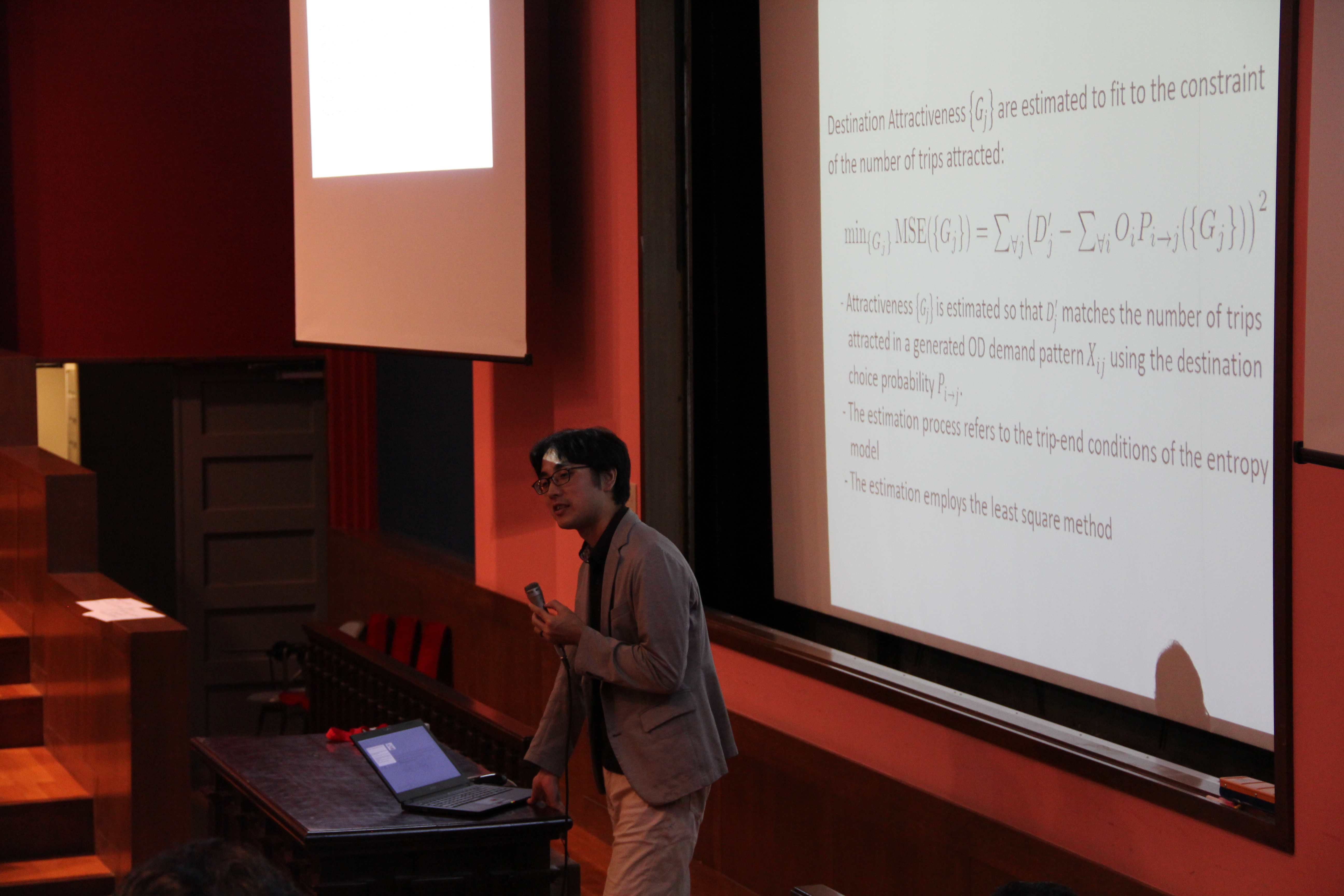
|
研究奨励賞受賞者 Invited Lectures
About BinN student research award 2018 (Selection Reason)
|
Hajime Watanabe (Kumamoto Univ.) MDCEV model was developed to show how much time-use on weekdays has an effect on that on holidays. The data in Yokohama city and Matsuyama city was used and showed the difference of time-use between urban and rural area. Applied panel-MDCEV model, the number of statistically significant variables decreases. Weekday time-use variables significantly influence holiday time-use behavior in Yokohama, but not in Matsuyama. The dominant factors affecting activity time-use behavior on holidays are different in the two cities. (PDF Document) |

|
|
Riki Kawase (Kobe Univ.) |
-
演習 Group work
課題:プローブパーソンデータを用いた行動モデル推定
プローブパーソンデータ(ロケーションデータ,ウェブダイアリー)・土地利用データ・交通ネットワークデータを用いて,離散選択モデルをはじめとした行動モデルの構築と推定を,4~6人での班ごとに行い,成果を発表しました.

|
Abstract:This time we tried to evaluate the impact of trip chaining on mode choices for Yokohama city. We used the Person Trip data for 2010 which gave information regarding trip chaining behavior of around 3 lakh individuals. We initiated our work with a series of OLS and MNL to identify the importance of trip chaining. Then, our work was further enriched by utilizing MNL, NL and MDCEV to arrive at the following results:1. Different modes were used in cases of higher number of trip chains. 2. In contrary, only single type of motorized modes (car/rail) were used for lower number of trip chains. 3. For combined use of modes, people prefer to use car and two wheeler for conducting higher number of trip chains.
|

|
発表概要:Analysis of Individual Behavior in Yokohama Using Activity-Scheduled Choice Model
|

|
発表概要:シャイニングマンデー導入時の横浜市における週末の活動時間選択
|

|
Gチーム(Univ.Tokyo & UCP) pdf / code Abstract:We estimated the parameters of the beta-scaled recursive logit model using the PP data in Matsuyama city. We have got a convincing result and some significant parameters on the path choice mechanism of car users, although it required much computation power (11 hours to converge). In addition to the parameter estimation, we conducted a policy-simulation based on the result of the estimation. Concretely, we virtually prohibited the car traffic on some roads in the central Matsuyama and evaluated the change in traffic flow. We simulated 4 cases and got reasonable results in each case.
|

|
発表概要:MNLモデル、NLモデルを用いた横浜市現状把握
|

|
発表概要:松山における高齢化に伴う公共交通機関の受容性に関する分析
|

|
team K(Nagoya Univ.c) pdf / code Title:Potential of On-demand Mobility and Real-time Trip Planning in Yokohama City
|

|
発表概要:TASHAを用いた時間帯別行動分析
|

|
発表概要:付加価値を考慮した交通手段選択のシミュレート
|

|
Oチーム(Hiroshima Univ.b) pdf / code Abstract:The objective of the study is to determine the travel behavior differences across generations and between gender in Yokohama City. We want to promote active transportation especially for short distance trips. The rationale for our goal is based on the happiness parameters from the World Happiness Report. By designing cities that are conducive for a healthy and active life, more citizens may be happy. Our study employed the MNL and NL models for segmented transportation mode choice analysis of commuting behavior.
|

|
発表概要:健康増進を目的とした交通手段選択モデル
|
表彰 Award
行動モデル夏の学校には例年,数理的にモデリングをつめられていたグループには,故・上田孝行先生にちなんだ香住賞が,行動分析によって興味深いfact findingを実現したグループには,故・北村隆一先生にちなんだDavis賞が,モデルの精度指標の一つである尤度比が最も高かったグループには,尤度比賞が送られます.今年度の受賞チームは以下の通りです.
香住賞:Bチーム(東京工業大学),Mチーム(神戸大学)
Davis賞:Lチーム(山梨大学)
尤度比賞:Pチーム(愛媛大学)
1位:Pチーム(愛媛大学) 2位:Lチーム(山梨大学)、Gチーム(東京大学&University of Central Punjab)
4位:Aチーム(Indian Institute of Technology Bombay)、Bチーム(東京工業大学)、Mチーム(神戸大学)







